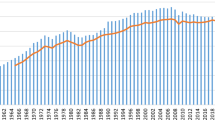Abstract
The paper using data on 114 countries during 1992–2004 identifies the major perpetrators of escalating global emissions. Using the LMDI decomposition technique, we examine the contribution of the major factors in changing the level of emissions. The effect of GDP on emission is found to be substantially more than that of population. However, the income effect shows high fluctuation over time, while the population effect has been roughly constant. The upper middle-income countries, particularly of Europe and Central Asia, despite high economic growth have reduced their emissions substantially, while in the countries of North America, East Asia Pacific and South Asia increase in income have been significantly accompanied by increase in emission. Apart from few low emitting countries, almost all others have been successful in increasing emission efficiency, but their energy efficiencies have not been remarkable. Although emission efficiency has been more instrumental in curtailing emission, in some cases the path of change in emission follows that of change in energy intensity. Thus, both energy and emission intensity have crucial roles in determining the level of emissions. It may be suggested that emphasis should be given on policies oriented towards sufficient counteractive energy and emission efficiencies before embarking on a path towards economic growth.
Similar content being viewed by others
Notes
In ‘IPAT’, it is considered that I = P × A × T.
Birdsall (1992) has specified two mechanisms through which population growth could contribute to emissions. First, a larger population could result in increased demand for energy for power, industry and transportation, hence the increasing emissions. Second, population growth could contribute to emissions through its effect on deforestation. The destruction of the forests, changes in land use, and combustion of fuel wood could significantly contribute to emissions.
The concept is similar to environmental Kuznets hypothesis.
A notable among them is World Bank (2007) that provides a decomposition of the change in fossil fuel CO2 emissions between 1994 and 2004 for 70 countries.
See data.un.org.
See worldbank.org.
Based on the World Bank classifications.
Calculated from available UN data for 204 countries.
Karakaya and Özcag (2005) in their analysis argued that the reduction in emissions of former Soviet Union countries is mainly due to the crisis experienced by them after gaining their independence; population effect is mainly stable, while with energy-saving and carbon-reduction plans most of the countries have improved their energy intensities. However, in some countries like Germany, Poland, Switzerland, etc. though the feature is not applicable, they have reduced their emissions.
Except in case of Haiti, in the other three countries the combined effects of emission and energy intensities reinforce the negative effects of income and population.
References
Ang BW (2005) The LMDI approach to decomposition analysis: a practical guide. Energy Policy 33:867–871
Birdsall N (1992) Another look at population and global warming, Policy research working papers. No. 1020., Washington DC, The World Bank
Bongaarts J (1992) Population growth and global warming. Population and Development Review 18:299–319
Dietz T, Rosa EA (1994) Rethinking the environmental impacts of population, affluence, and technology. Human Ecology Review 1:277–300
Dietz T, Rosa EA (1997) Effects of population and affluence on CO2 emissions. Ecology 94:175–179
Ehrlich P, Holdren J (1971) Impact of population growth. Science 171:1212–1217
Engleman R (1998) Profiles in carbon: an update on population, consumption and carbon dioxide emissions. Population Action International, Washington, DC
Karakaya E, Özcag M (2005) Driving forces of CO2 emissions in central Asia: A decomposition analysis of air pollution from fossil fuel combustion. Arid Ecosystems Journal 11(26–27):49–57
Kaya Y (1990) Impact of carbon dioxide emissions control on GNP growth: interpretation of proposed scenarios, paper presented to IPCC Energy and Industry Sub-group, Response Strategies Working Group
Martínez-Zarzoso I, Bengochea-Morancho A, Morales-Lage R (2006) The impact of population on CO2 emissions: evidence from European countries, The Fondazione Eni Enrico Mattei Note di Lavoro Series Index: http://www.feem.it/Feem/Pub/Publications/WPapers/default.htm
O’ Neill BC, MacKellar FL, Lutz W (2001) Population and climate change. Cambridge University Press, Cambridge
Onozaki K (2009) Population is a critical factor for global carbon dioxide increase. J Health Sci 55(1):125–127
Shi A (2001) Population growth and global carbon dioxide emissions, paper presented at IUSSP Conference in Brazil/session-s09
Shi A (2003) The impact of population pressure on global carbon dioxide emissions, 1975–1996: evidence from pooled cross-country data. Ecological Economics 44:29–42
Smil V (1990) Planetary warming: Realities and responses. Population and Development Review 16(1):1–29
World Bank (2007) Growth and CO2 emissions: how do different countries fare? Environment Department
Acknowledgment
We are thankful to Prof. Ratan Khasnabis, University of Calcutta for his valuable comments.
Author information
Authors and Affiliations
Corresponding author
Appendix
Appendix
See Tables 1, 2, 3, 4, 5, 6, 7, 8, 9 and Figs. 1, 2, 3, 4, 5, 6, 7, 8, 9, 10, 11, 12, 13, 14, 15, 16, 17, 18, 19, 20, 21, 22, 23.
Rights and permissions
About this article
Cite this article
Pani, R., Mukhopadhyay, U. Identifying the major players behind increasing global carbon dioxide emissions: a decomposition analysis. Environmentalist 30, 183–205 (2010). https://doi.org/10.1007/s10669-010-9256-y
Published:
Issue Date:
DOI: https://doi.org/10.1007/s10669-010-9256-y



























